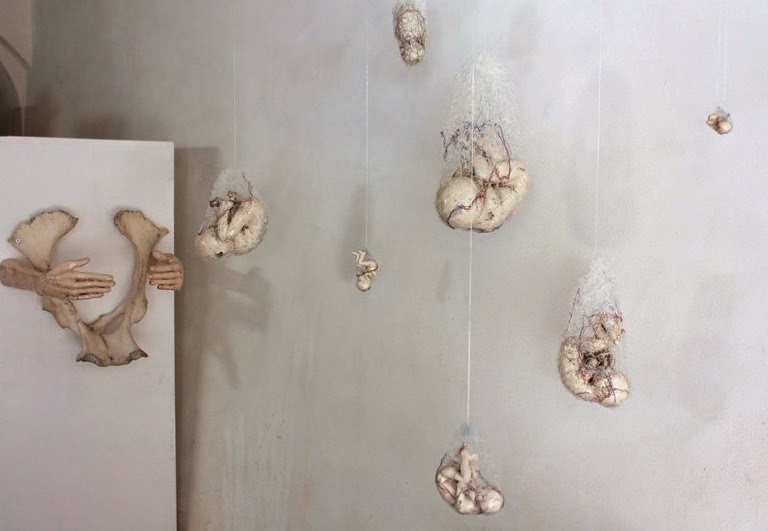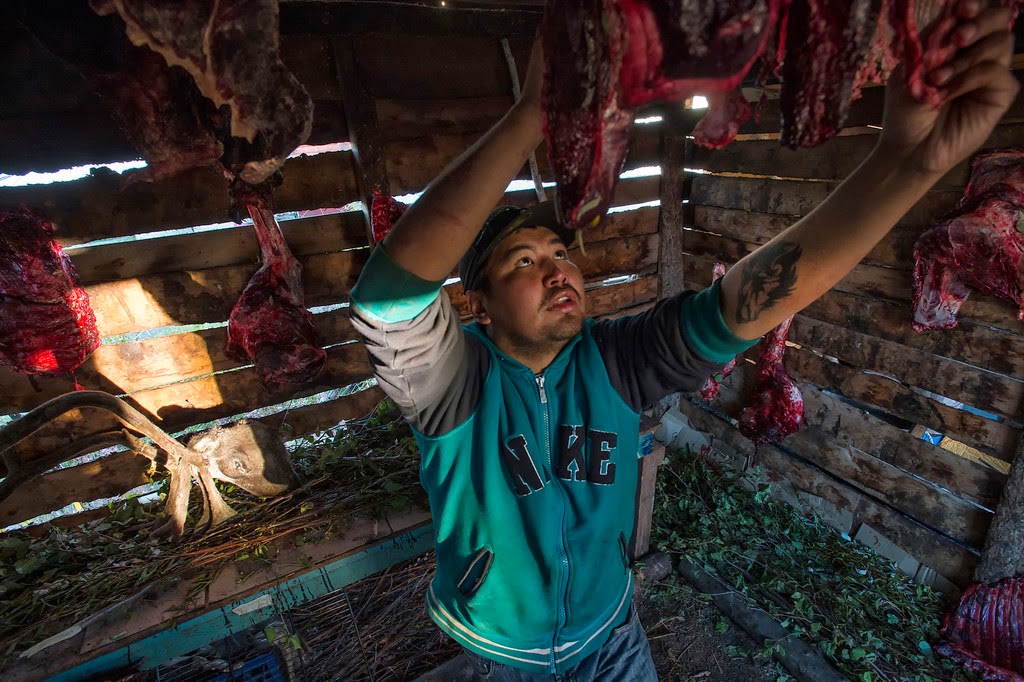The Paper Coyote
This blog is about art that inspires me. Taxidermy, anatomy, drawings, art books, printmaking, animals, science, gender, and of course, coyotes.
8.21.2014
Caterina Silenzi a Raku Shaman.
Caterina Silenzi creates her work by combining animal remains with ceramics. She uses the ancient Japanese technique of Raku, a long and complex procedure whose main elements are fire, air, water and earth. Combined with extreme temperatures the firing is akin to a crematorium, turning the craft into a sort of shamanistic ritual and creating a new life.
I love the understated narrative of Caterina's work. Her work adeptly evokes emotion from the viewer through the tragic and beautiful juxtaposition of the animal remains and the new creation. This paradoxical presentation is the embodiment of beauty and sadness, life and death and traps the viewer in a space somewhere between the two. There is no definitive beginning or end in her portrayal of the "circle of life" and the point where the two become one is a place we aren't often forced to examine.
Although she hasn't posted anything new in quite some time, I really hope to see more of her work. Maybe her absence is because she is busy crafting a new story and delivering us the magic of another life reborn.
You can see more of Caterina's work on her website.
8.11.2014
Nastasja Duthois embroidery magic
Embroidered Silhouettes by Nastasja Duthoisby Christopher Jobson on June 19, 2014









Artist Nastasja Duthois creates large installations and small-scale embroidered artworks that explore aspects of shadow and negative space. Though composed of thousands of straight sewn lines reminiscent of crosshatching, the final pieces are generally organic in form from the silhouettes of dogs and animals to more complex landscapes. You can see more of her work over on BASE and on her website.
8.06.2014
Lyndie Douthe
I found artist Lyndie Douthe on Pinterest. I know I know you're starting to think I have an addiction or something. I was struck by the delicacy and subject matter. Severed fingers, tiny love letters, anatomical bits, illness, rotting fruit complete with flies, and skeletons don't seem to be common subjects for fibre artists.
I absolutely love being surprised by work that doesn't fit a mold or into one of my preconceived notions of what it is. By now you all know I love the dead things, anatomy, and boxes of bones but these objects were just so delightfully unusual that I had to share them.
Lyndie Douthe's website showcases her work and I love being able to get a look at another artists' process. I also love being able to see the evolution of her work over the course of a few years. It is a different take on the memento mori theme both in subject matter and from a craft that is historically and canonically dominated by women. Her website contains her blog, written in French where she talks about her work and travels and documents the process behind her creations as well as a store where you can purchase something that tickles your fancy or request a custom piece. I have my eye on the "broken" hearts and just might have to order me one!
You can read more about her (in English) here.
What are your thoughts?
-Janv14-13.jpg)
-Mai14-1.jpg)
6.03.2014
Sambaa K'e Print Studio
I had the opportunity to visit the emerging Sambaa K'e Print Studio located in the remote subarctic community of Trout Lake in the Northwest Territories. When I first moved to the North in 2010, I read a newspaper article about a small Aboriginal community that was starting up a print studio as a way to encourage their residents to make art, tell stories, and record their history and culture.
The first workshops that were done there were gyotaku or making prints from the bodies of real fish. I thought it was an interesting way to introduce a group to printmaking while still incorporating an essential element of the life, culture of the area and people.
Ever since I read that article, I have been interested in seeing it with my own eyes and I serendipitously had the chance to visit it in person while on duty travel for work.
During my extremely short visit, I had the opportunity to meet Gavin Renwick, who in partnership with the Sambaa Ke Dene "invited printmakers Paul Harrison, of the Visual Research Centre, University of Dundee, and Scott Hudson, of Dundee Contemporary Arts, to develop a series of training workshops based on, and through, the medium and practice of printmaking."[1]
I sat down with Gavin for a few minutes to chat about printmaking, the Sambaa K'e Studio and their plans for the future. I told him about the print exchange I started as a way to bring together northern printmakers from around the globe who were more likely to be working in isolation. The goal of the exchange project is to auction off one of the works from each edition with the proceeds of the auction going to help a remote studio purchase supplies.
My hope was to donate the proceeds from the first exchange to the Sambaa K'e Print Studio. I invited them to participate and hope that I will have a few artists from Trout Lake participate.
The Studio self published a book as well that details the beginnings of the program and features some of the work that has been done. You can purchase a copy of the book on blurb. Visit their website to see more about the studio, programs, and more of their work.
The first workshops that were done there were gyotaku or making prints from the bodies of real fish. I thought it was an interesting way to introduce a group to printmaking while still incorporating an essential element of the life, culture of the area and people.
Ever since I read that article, I have been interested in seeing it with my own eyes and I serendipitously had the chance to visit it in person while on duty travel for work.
During my extremely short visit, I had the opportunity to meet Gavin Renwick, who in partnership with the Sambaa Ke Dene "invited printmakers Paul Harrison, of the Visual Research Centre, University of Dundee, and Scott Hudson, of Dundee Contemporary Arts, to develop a series of training workshops based on, and through, the medium and practice of printmaking."[1]
I sat down with Gavin for a few minutes to chat about printmaking, the Sambaa K'e Studio and their plans for the future. I told him about the print exchange I started as a way to bring together northern printmakers from around the globe who were more likely to be working in isolation. The goal of the exchange project is to auction off one of the works from each edition with the proceeds of the auction going to help a remote studio purchase supplies.
My hope was to donate the proceeds from the first exchange to the Sambaa K'e Print Studio. I invited them to participate and hope that I will have a few artists from Trout Lake participate.
The Studio self published a book as well that details the beginnings of the program and features some of the work that has been done. You can purchase a copy of the book on blurb. Visit their website to see more about the studio, programs, and more of their work.
4.16.2014
Peter Mather Documents a Changing Arctic
Peter Mather is a photographer from Yukon Canada who documents the land and people of this arctic territory. He describes his work as a hybrid of fine art photography and documentary photography and his images can be quite startling yet beautiful much like the arctic itself. The photos below are from Yukon, NWT, and Alaska.
Far from an icy wasteland, the arctic is a fragile yet unforgiving wilderness populated with resilient people, plants and animals that thrive in some of the most challenging conditions in the country. People in the arctic have a strong relationship with the land. The weather, the animals, and the hunt all feed into a strong emotional bond with the very ground under their feet. They are well aware of the richness and bounty of the arctic and with the demand for resources at an all time high, greed threatens to destroy this delicate balance. Peter Mather is there documenting these relationships, the land, the people, and all the other precious things that risk getting lost in the quest for more.
You can see more of his images on his website or contact him via his facebook page.

All images © Peter Mather
Far from an icy wasteland, the arctic is a fragile yet unforgiving wilderness populated with resilient people, plants and animals that thrive in some of the most challenging conditions in the country. People in the arctic have a strong relationship with the land. The weather, the animals, and the hunt all feed into a strong emotional bond with the very ground under their feet. They are well aware of the richness and bounty of the arctic and with the demand for resources at an all time high, greed threatens to destroy this delicate balance. Peter Mather is there documenting these relationships, the land, the people, and all the other precious things that risk getting lost in the quest for more.
You can see more of his images on his website or contact him via his facebook page.

All images © Peter Mather
Subscribe to:
Posts (Atom)













parfaits(5)-juin14-1.jpg)
.jpg)
-Aout13-1.jpg)
.jpg)
-2.jpg)
-Oct12-2.jpg)
-Janv14-8.jpg)
-11.jpg)
-Avril12-2.jpg)
-Avril12-3.jpg)
-sept11-6.jpg)
+-+copie.jpg)
-Mai12-2.jpg)



















